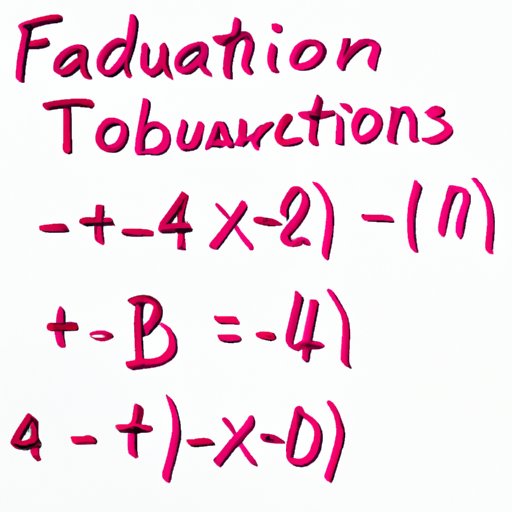
Introduction
Trinomial factoring is an essential skill that every math student needs to master. It involves breaking down a quadratic expression into its simplest form, a process that plays a vital role in solving many math problems. In this article, we’ll provide a step-by-step guide to mastering trinomial factoring, along with handy tips and tricks, different methods for factoring, and real-world applications.
Mastering Trinomial Factoring: A Step-by-Step Guide
Factoring trinomials is a three-step process that involves identifying the greatest common factors, grouping terms, and applying algebraic formulas. Let’s break down each step using an example.
Example: Factor x^2 + 3x + 2
Step 1: Identify the greatest common factor
Looking at the coefficients of the terms, we can see that 1 is the largest number that goes into each of them, so we know that our common factor is 1.
x^2 + 3x + 2 = 1(x^2) + 1(3x) + 1(2)
Step 2: Group like terms
We group the like terms together in two pairs:
x^2 + x + 2x + 2 = (x^2 + x) + (2x + 2)
Step 3: Apply algebraic formulas
We can then factor each pair separately, using the following formulas:
x^2 + x = x(x + 1) and 2x + 2 = 2(x + 1)
Putting it all together, we get:
x^2 + 3x + 2 = (x + 1)(x + 2)
Quick Tips for Factoring Trinomials Like a Pro
Here are some tips to help make factoring trinomials easier and more efficient:
- Always look for the greatest common factor first.
- Write out all of the possible factor pairs for the constants in the expression and try them out until you find a match.
- If you’re not sure where to start, make a list of the factors of the first and last term and look for pairs that add up to the middle term.
- Double check your work by multiplying the factors back out to confirm that they give you the original expression.
- Practice, Practice, Practice – the more you do it, the easier it will become.
The Different Methods for Factoring Trinomials: Which One Works Best for You?
There are different methods for factoring trinomials, and each one has its pros and cons. Here are some of the most commonly used methods:
- Factoring by grouping – involves grouping terms with common factors and then factoring out the GCF
- The AC method – involves finding the product of the first and last coefficients and then finding factors of this product that sum to the middle coefficient
The key to determining which method to use is to practice and develop familiarity with each one. Some methods will work better for certain problems than others, and over time, you’ll develop your preferences and strategies for approaching different types of problems.
Overcoming Common Challenges in Trinomial Factoring
Factoring trinomials can be challenging at times, but with the right strategies and persistence, you can overcome most obstacles. Here are some common roadblocks and how to get past them:
- Keep in mind that all problems have a solution – sometimes it just takes a little longer to find it.
- Break the problem down into smaller steps and tackle them one at a time.
- If you get stuck, try a different factor pair or method.
- Brush up on basic algebra skills, such as multiplying and factoring monomials or using the distributive property.
Real-World Applications of Trinomial Factoring
Trinomial factoring has many real-world applications, such as in engineering, physics, or computer science. For example, in engineering, factoring trinomials can help in the design and optimization of systems that involve quadratic functions, such as control systems or feedback loops. In physics, trinomial factoring plays a role in areas such as kinematics, energy, or force problems, where quadratic equations can often provide solutions. In computer science, trinomial factoring is used in cryptography, data compression, and other areas where math plays a role. By mastering trinomial factoring, you’ll be equipped to solve a broad range of problems across these fields and beyond.
Conclusion
Trinomial factoring may seem challenging at first, but with practice and perseverance, you can master this essential skill and build a foundation for more advanced math concepts. By following the step-by-step guide, using quick tips and tricks, exploring different methods, and overcoming common challenges, you’ll be on your way to becoming a pro at factoring trinomials. We hope this article has been informative and helpful in your journey to mastering this fundamental concept.





